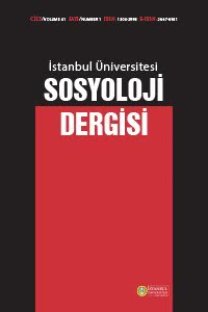İç savaş ve savaş sonrası İspanyası'nın ilk döneminde toplumsal değişim
İç Savaş sonrası İspanyası, 1939-1950 yılları arasında ele alındığında toplumsal yönden önemli değişimler yaşandığı gözlemlenir. Karaborsacı ve kaçakçıların yaşadığı rahat yaşam, açlıktan ölme sınırına gelen çoğu insan için zamanla özendirici bir hal alır. İspanyol sosyal ortamının açgözlülük ve sefalet ile tanımlanabilecek bu sıra dışı dönemi ve bu dönemde artan suç oranları, incelenmesi gereken bir toplumsal olay niteliği taşır. İç savaş öncesinde suçla ilişkisi olmayan sayısız İspanyol yurttaş, iç savaş sırasında kısa sürede suçlu kimliğine bürünmüştür. Bu dönemde, bireysel suçlar ve çete suçları artmış, çeşitli sahtecilik, hırsızlık ve kaçakçılık yöntemleri gözlemlenmiştir. Kıtlık ve yasal baskıların olduğu bir ortamda savaşın yaralarını sarmak da zor olmuştur. Sonuç olarak İspanyanın iç savaş sonrası örneği, bir toplumun sosyal ve ekonomik dengeleri sarsıldığında bununla eşzamanlı olarak ahlaki açıdan da yıprandığını bize gösterir. Toplumun önemli bir kesimi tarafından desteklenen ve savaş öncesinin yönetim düzensizliklerine ve ekonomik sorunlarına çare olacağı düşünülen General Francisco Franco, tüm bunlara çözüm olamaz. Savaş sonrasının ilk döneminde halk için yaşam şartları daha da kötüleşir.
The spanish civil war and the social change in the first period of postwar Spain
When Postwar Spain is discussed (1939-1950), it is observed that important changes surfaced in the social aspect. The comfortable lives of black marketeers and contrabandists became incentives for the ones that were on the edge of dying of hunger. The extraordinary period of Spanish social ambiance that can be defined with greed and misery, and the rising crime rates in this era, are both social events that need to be examined. In addition to the ones that committed crimes to survive, there also appeared many disaster opportunists. In the mentioned period, the rise in the civil and gang crimes, and various methods of forgery, robbery and contrabandism were observed. In an ambience of shortages and legal pressures, the wounds of the war took time to heal. As a result, Spain s Postwar example demonstrates us that the society can be damaged morally in parallel with the damaged social and economic balances. General Franco who was supported by many citizens and believed to normalize the administrative instability and economic problems of the prewar, was not a solution for all these. In the first period of the postwar, living conditions of the Spanish citizens grew even worse.
___
- ABC. (1976). 70 Años de España a traves de ABC (Vol. 2). Madrid: ABC.
- Abella, R. (1978). Por el Imperio hacía Dios. Crónica de una postguerra. Barcelona: Planeta.
- Abellán, M.L. (1980). Censura y creación literaria en España (1939-1976). Barcelona: Península.
- Balfour, s. (2001). Dictatorship, Workers and The City (Labour in Greater Barcelona since 1939). New York: Oxford University Press.
- Biescas, J. A.(1980). Historia de España, España Bajo La Dictadura Franquista (1939-1975). Barcelona: Labor.
- Bussy Genevois, D.(1992). Cumhuriyetten Francoya İspanyanın Kadınları. G. Duby & M. Perrot, (Ed.), Kadınların Tarihi, Yirminci Yüzyılda Kültürel Bir Kimliğe Doğru (Cilt V) içinde (ss.168-182). A.Fethi. (Çev.). İstanbul: İş Bankası Yayınları.
- Ealham, C. (1995). Anarchism and Illegality in Barcelona, 1931-1937. Contemporary European History (Vol. 4) içinde (ss.133-151). Cambridge: Cambridge University Press.
- Ferrando Badía, J. (1984). El Régimen de Franco. Madrid: Tecnos.
- Graham, H. (1996). Gender and the State: Women in the 1940s. H. Graham ve J. Labanyi, (Eds.), Spanish Cultural Studies (An Introduction) içinde (ss.182-195). Oxford: Oxford University Press.
- Ilie, P. (1981). Literatura y exilio interior (Escritores y sociedad en la España franquista). Madrid: Espiral.
- Juliá, s. (2006). Memoria de la Guerra y del Franquismo. Madrid: Taurus.
- Martin Gaite, C. (1994). Usos amorosos de la posguerra española. Barcelona: Anagrama.
- Martín Patino, B.(1976). Canciones para después de una guerra [película]. España: Turner Films S.A.
- Martínez Martín, J. & Limón, F. (1997). El abastecimiento de la población. Sociedad y Guerra. La Guerra Civil Española. Barcelona: Ediciones Folio.
- Miguel, A. de (1998). La España de Nuestros Abuelos. Historia íntima de una época. Madrid: Espasa Calpe.
- Pla y Deniel, E. (1938). Los delitos del pensamiento y los falsos ídolos intelectuales. Salamanca: Est. tip.de Calatrava.
- Preston, P. (2006). The Spanish Civil War, Reaction, revolution & revenge. London: Harper Perennial.
- Ros Gimeno, J. (1959). Las clases sociales y el problema de su determinación. Revista Internacional de Sociología, 65, 41-45.
- Sinova, J. (1989). La censura de Prensa durante el franquismo. Madrid: Espasa-Calpe.
- Sotelo Alvarez, A. (1995). Carmen de Cinco Horas con Mario de Miguel Delibes y mujer española en el franquismo. Ourense: Ediciones Universitarias.
- Tezanos, J. F. (1990). Clases sociales. S.Giner, (Ed.). España. Sociedad y política içinde (ss.109-141) Madrid: Espasa Calpe.
- Vázquez Montalbán, M. (1971). Crónica sentímental de España. Barcelona: Lumen.
- Vinyes, R. (2002). Irredentas. Las presas políticas y sus hijos en las cárceles españolas. Madrid: Temas de Hoy.
- Vizcaíno Casas, F. (1978). La España de la postguerra 1939-1953. Barcelona: Planeta.
- Wright, R. (1957). Pagan Spain. New York: University Press of Mississippi.
- ISSN: 1304-2998
- Başlangıç: 2020
- Yayıncı: İstanbul Üniv. Edebiyat Fak. Sosyoloji Böl.
